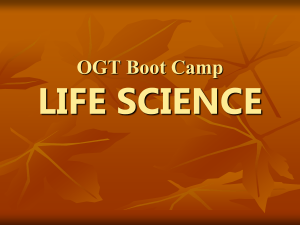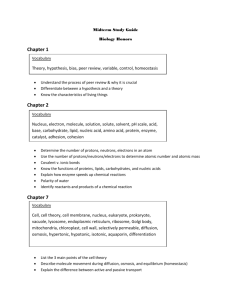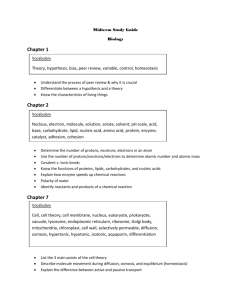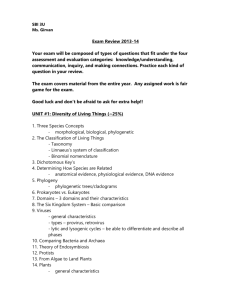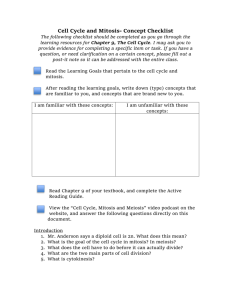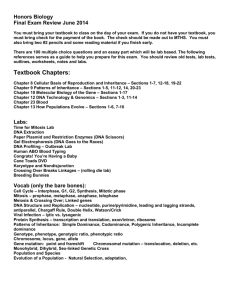BIOL0601 Module 3 Guide G
advertisement
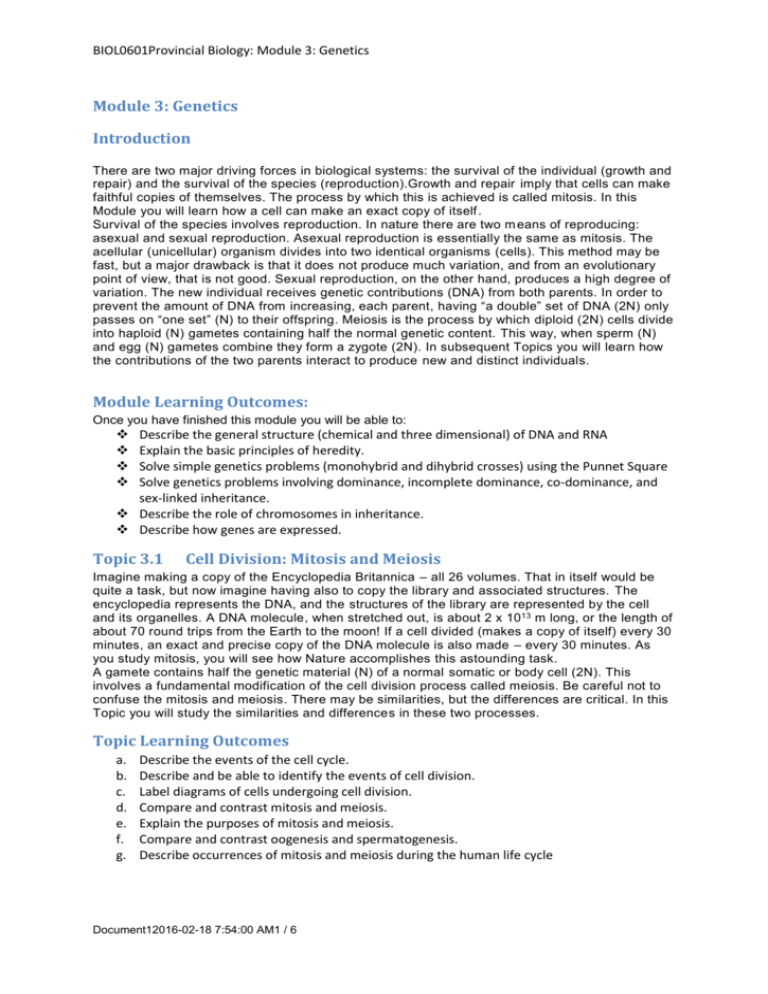
BIOL0601Provincial Biology: Module 3: Genetics Module 3: Genetics Introduction There are two major driving forces in biological systems: the survival of the individual (growth and repair) and the survival of the species (reproduction).Growth and repair imply that cells can make faithful copies of themselves. The process by which this is achieved is called mitosis. In this Module you will learn how a cell can make an exact copy of itself . Survival of the species involves reproduction. In nature there are two m eans of reproducing: asexual and sexual reproduction. Asexual reproduction is essentially the same as mitosis. The acellular (unicellular) organism divides into two identical organisms (cells). This method may be fast, but a major drawback is that it does not produce much variation, and from an evolutionary point of view, that is not good. Sexual reproduction, on the other hand, produces a high degree of variation. The new individual receives genetic contributions (DNA) from both parents. In order to prevent the amount of DNA from increasing, each parent, having “a double” set of DNA (2N) only passes on “one set” (N) to their offspring. Meiosis is the process by which diploid (2N) cells divide into haploid (N) gametes containing half the normal genetic content. This way, when sperm (N) and egg (N) gametes combine they form a zygote (2N). In subsequent Topics you will learn how the contributions of the two parents interact to produce new and distinct individuals. Module Learning Outcomes: Once you have finished this module you will be able to: Describe the general structure (chemical and three dimensional) of DNA and RNA Explain the basic principles of heredity. Solve simple genetics problems (monohybrid and dihybrid crosses) using the Punnet Square Solve genetics problems involving dominance, incomplete dominance, co-dominance, and sex-linked inheritance. Describe the role of chromosomes in inheritance. Describe how genes are expressed. Topic 3.1 Cell Division: Mitosis and Meiosis Imagine making a copy of the Encyclopedia Britannica – all 26 volumes. That in itself would be quite a task, but now imagine having also to copy the library and associated structures. The encyclopedia represents the DNA, and the structures of the library are represented by the cell and its organelles. A DNA molecule, when stretched out, is about 2 x 1013 m long, or the length of about 70 round trips from the Earth to the moon! If a cell divided (makes a copy of itself) every 30 minutes, an exact and precise copy of the DNA molecule is also made – every 30 minutes. As you study mitosis, you will see how Nature accomplishes this astounding task. A gamete contains half the genetic material (N) of a normal somatic or body cell (2N). This involves a fundamental modification of the cell division process called meiosis. Be careful not to confuse the mitosis and meiosis. There may be similarities, but the differences are critical. In this Topic you will study the similarities and differences in these two processes. Topic Learning Outcomes a. b. c. d. e. f. g. Describe the events of the cell cycle. Describe and be able to identify the events of cell division. Label diagrams of cells undergoing cell division. Compare and contrast mitosis and meiosis. Explain the purposes of mitosis and meiosis. Compare and contrast oogenesis and spermatogenesis. Describe occurrences of mitosis and meiosis during the human life cycle Document12016-02-18 7:54:00 AM1 / 6 BIOL0601Provincial Biology: Module 3: Genetics Learning Activities for Topic 3.1 Done √ √ Task Activity Description HINT: Read everything before doing anything! Before you proceed further in Module 3 of this course, take time to review the activities in the module and identify the resources that you need to obtain – this way you will be sure you have them available when you need them! READ Chapter 18: Sections 2 through 6 CHECK Progress Check your Progress Sections 2, 3, 4, 5 and 6 HINT: Complete the Check Your Progress sections as you come across them. They will help you pick out the key ideas and to check that you understand the reading. √ LAB ACTIVITY Lab 3A - Mitosis Complete the lab by filling in the data tables and completing the questions in Thinking About the Results. The lab instructions are to be found at the end of the assignment. The lab will be submitted along with the completed Module Assignment. The pocket microscope does not give us the magnification required to observe the behaviour of the chromosomes during mitosis. To do this, pictures of cells undergoing mitosis have been taken and placed on the CD. You will need access to a computer with a CD/DVD drive to use this resource. Review Activities for Topic 3.1 OPTIONAL REVIEW MATERIAL On-Line “CONNECT” If you have an Internet connection, you can use "Connect". These extra pictures, video Clips and activities are provided by the textbook publisher. They are not required for the course, but they can be very interesting. The URL for the site is: http://highered.mcgraw-hill.com/sites/0073525464/student_view0/index.html If this link is not clickable, copy and paste it into your browser address bar. Connect resources include practice tests, animations and videos, pictures, PowerPoint slides of the illustrations from the text and flashcards. Read over "Summarizing the Concepts" for the chapter/sections covered. It is useful to help you focus on the important concepts covered in the Topic. The Key Concepts section highlights the important ideas/concepts from the chapter. Be sure you can define each and understand its importance. Be careful to watch your time. Connect should only be looked at once you have done the required learning activities. √ REVIEW You should be able to define or describe these key concepts: The cell cycle The phases of Mitosis o interphase Document12016-02-18 7:54:00 AM2 / 6 BIOL0601Provincial Biology: Module 3: Genetics o early prophase o late prophase o metaphase o anaphase o telophase Cytokinesis Meiosis Chromosome Inheritance √ VOCABULARY List new words and allow space for you to write definition in your own words. This glossary of technical terms will be important for you for test and final examination preparation. √ SELF TEST Do the following questions: Testing Your Knowledge - Chapter 18: 1 – 13, 16 – 22, 23 - 36 Topic 3.2 Simple Inheritance A young man from Vancouver Island married a young lady from Saskatchewan. Their first child was a healthy boy. Their second child was a girl who had PKU, a genetic defect which, if not caught early, could cause great neurological damage. Neither of them was aware of any previous occurrence of PKU in their families, so how did this happen to them? Gregor Mendel (1822-1884) was the first to systematically study inheritance, and to begin to explain how characteristics are passed from one generation to the next. In this topic you will consider study two simple examples of this: the monohybrid cross and the dihybrid cross. Topic Learning Outcomes a. b. c. d. e. f. Distinguish between a phenotype and a genotype. Distinguish between a gene and an allele. Describe the principles of inheritance. Solve genetics problems involving one-trait and two-trait crosses. Use a Punnet Square to solve genetics problems. Describe the patterns of inheritance of phenotypes: dominant, recessive, incomplete dominance, co-dominance, multiple alleles. Learning Activities for Topic 3.2 Done √ √ Task Activity Description HINT: Read everything before doing anything! Before you proceed further in Module 3 of this course, take time to review the activities in the module and identify the resources that you need to obtain – this way you will be sure you have them available when you need them! READ Chapter 20: Section 1 CHECK Progress Check your Progress Section 20.1 HINT: Complete the Check Your Progress sections as you come across them. They will help you pick out the key ideas and to check that you understand the reading. √ SELF TEST READ Do the following questions: Testing Your Knowledge – Chapter 20: 1 Chapter 20: Section 2 Document12016-02-18 7:54:00 AM3 / 6 BIOL0601Provincial Biology: Module 3: Genetics √ CHECK Progress Check your Progress Section 20.2 HINT: Complete the Check Your Progress sections as you come across them. They will help you pick out the key ideas and to check that you understand the reading. √ LAB ACTIVITY Lab 3B – The Monohybrid Cross Complete the lab by filling in the data tables and completing the questions in Thinking About the Results. The lab instructions are to be found at the end of the assignment. The lab will be submitted along with the completed Module Assignment. For this lab you will need small 10 objects that are distinguishable ONLY by colour. This may be 10 jelly beans (5 red and 5 black), 10 smarties (5 of each colour) or any other such object. √ LAB ACTIVITY Lab 3C – The Dihybrid Cross Complete the lab by filling in the data tables and completing the questions in Thinking About the Results. The lab instructions are to be found at the end of the assignment. The lab will be submitted along with the completed Module Assignment. √ √ READ Chapter 20: Section 3 and 4 CHECK Progress Check your Progress Section 20.3 and 20.4 HINT: Complete the Check Your Progress sections as you come across them. They will help you pick out the key ideas and to check that you understand the reading. Review Activities for Topic 3.2 OPTIONAL REVIEW MATERIAL On-Line “CONNECT” If you have an Internet connection, you can use "Connect". These extra pictures, video Clips and activitiesare provided by the textbook publisher. They are not required for the course, but they can be very interesting. The URL for the site is: http://highered.mcgraw-hill.com/sites/0073525464/student_view0/index.html If this link is not clickable, copy and paste it into your browser address bar. Connect resources include practice tests, animations and videos, pictures, PowerPoint slides of the illustrations from the text and flashcards. Read over "Summarizing the Concepts" for the chapter/sections covered. It is useful to help you focus on the important concepts covered in the Topic. The Key Concepts section highlights the important ideas/concepts from the chapter. Be sure you can define each and understand its importance. Be careful to watch your time. Connect should only be looked at once you have done the required learning activities. √ REVIEW You should be able to define or describe these key concepts: genotype and phenotype gene and allele Document12016-02-18 7:54:00 AM4 / 6 BIOL0601Provincial Biology: Module 3: Genetics √ dominant and recessive monohybrid (single trait) and dihybrid (two trait) crosses pedigree co-dominance and incomplete dominance multiple alleles VOCABULARY List new words and allow space for you to write definition in your own words. This glossary of technical terms will be important for you for test and final examination preparation. SELF TEST Do the following questions: Testing Your Knowledge – Chapter 20: 1 – 5, 7, 12 – 17, 20 Topic 3.3 The Chromosomal Basis for Inheritance Topic Learning Outcomes a. b. c. d. e. f. g. Describe the chromosomes in human cells. Explain how a karyotype is used to study human chromosomes. Explain how sex-linked traits are inherited. Explain how human gender is determined. Solve genetics problems involving sex-linked characteristics. Describe a pedigree chart. Determine the mode of inheritance of a genetic trait from a pedigree chart. Learning Activities for Topic 3.3 Done √ √ Task Activity Description HINT: Read everything before doing anything! Before you proceed further in Module 2 of this course, take time to review the activities in the module and identify the resources that you need to obtain – this way you will be sure you have them available when you need them! READ Chapter 18: Section 1 (karyotype), Section 6 CHECK Progress Check your Progress Chapter 18: Section 1 and Section 6 HINT: Complete the Check Your Progress sections as you come across them. They will help you pick out the key ideas and to check that you understand the reading. √ √ READ Chapter 20: Section 3, 4 and 5 CHECK Progress Check your Progress Chapter 20: Section 3, 4 and 5 HINT: Complete the Check Your Progress sections as you come across them. They will help you pick out the key ideas and to check that you understand the reading. Review Activities for Topic 3.3 OPTIONAL REVIEW MATERIAL On-Line “”CONNECT” If you have an Internet connection, you can use "Connect". These extra pictures, video Clips and activities are provided by the textbook publisher. They are not required for the course, but they can be very interesting. The URL for the site is: Document12016-02-18 7:54:00 AM5 / 6 BIOL0601Provincial Biology: Module 3: Genetics http://highered.mcgraw-hill.com/sites/0073525464/student_view0/index.html If this link is not clickable, copy and paste it into your browser address bar. Connect resources include practice tests, animations and videos, pictures, PowerPoint slides of the illustrations from the text and flashcards. Read over "Summarizing the Concepts" for the chapter/sections covered. It is useful to help you focus on the important concepts covered in the Topic. The Key Concepts section highlights the important ideas/concepts from the chapter. Be sure you can define each and understand its importance. Be careful to watch your time. Connect should only be looked at once you have done the required learning activities. √ REVIEW You should be able to define or describe these key concepts: karyotype sex linked inheritance chromosomes and inheritance sex (gender) determination in humans using a pedigree polygenic inheritance √ VOCABULARY List new words and allow space for you to write definition in your own words. This glossary of technical terms will be important for you for test and final examination preparation. √ SELF TEST Do the following questions: Testing Your Knowledge –Chapter 18: 6, 10 – 12 Chapter 20: 6, 8 – 11, 18, 19 Thinking Critically: Chapter 20: 1 and 2 Submit Assignments ASST 3 Complete Assignment 3 and submit it along with all 3 Lab activities. If you are mailing your papers in be sure that your name and the assignment name appear clearly on your papers. If you are submitting your papers electronically, remember to name your file BIOL0601_assignmentX_first name_last name.doc and submit through the Assignments Button. MODULE 3 is COMPLETE! Document12016-02-18 7:54:00 AM6 / 6


